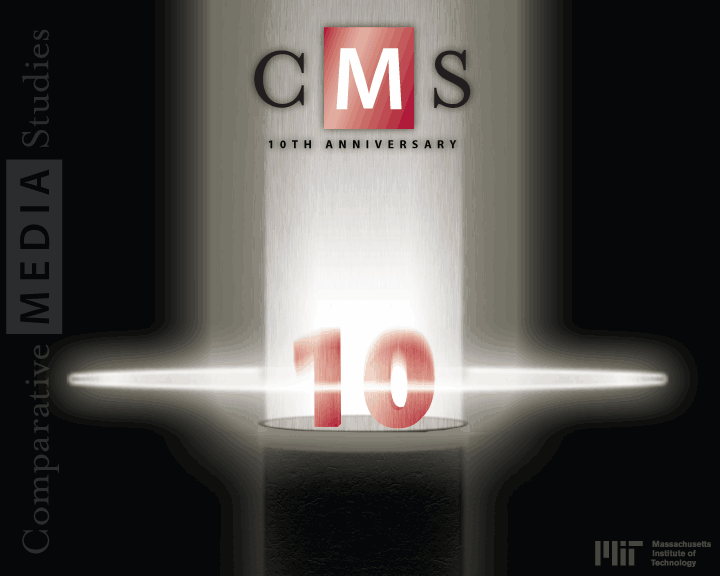
Welcome to the CMS 10th anniversary newsletter.
Looking back over this newsletter’s evolution from a photocopied and hand-stapled assemblage to the far more professional norms of recent years says more about our editorial and production staff than about the Program in Comparative Media Studies. Despite ten years of existence, we effectively remain a start-up: dynamic and responsive to environmental shifts; ad hoc in terms of some of our operations; extraordinarily ambitious; and growing in leaps and bounds. CMS has not lost the exhilarating sensation that I experienced a decade ago when I joined Henry Jenkins in the program’s first days. It’s been an amazing adventure, peopled by a cast of talented colleagues, superb students, and a dream administrative and research team.
We began with a formula that Henry liked to describe as stone soup: we provided the water and stones, and we scrounged around, cajoled, or just plain conned others into contributing whatever substantive morsels they could. Thanks to a brilliant recipe, a supportive faculty and dean, the talents of Alex Chisholm and Chris Pomiecko, and some very generous donors, CMS emerged as a hearty repast, richer and more nutritious than we had any right to expect. It was the right program at the right time.
CMS’s resilience manifested itself vividly in those early days. We ran head-on into the Y2K panic, 9/11, and the “dot bomb,” all of which proved disastrous for countless reasons, our fundraising efforts among them. But we came through. The tragedy of 9/11, for example, served to pull the CMS community together, and within a few days we produced re:constructions—reflections on humanity and media after tragedy, a website (web.mit.edu/cms/reconstructions) that remains a deeply creative and moving Zeitdokument. The common cause offered by this project, and the power of the community’s response, can in retrospect be read as a synecdoche for the larger CMS project. The aggregated commitment, passion and participation of the community—more than any structural resources—produced something meaningful, lasting, and some might argue, transformative. CMS still benefits from pro bono teaching, still thrives on the passion of its faculty, staff, and students, and still manages to spin gold from straw.
Despite tough times for stock portfolios and donors, a few stalwart friends prioritized the CMS program, and the program meantime developed an ever-larger cluster of funded research projects. You’ll read about the work of these projects in the coming pages, but to make a long story short, they enabled us to extend the work of the classroom, to test it, and in many cases, to have a very real impact in the world. And as if that impact were not enough, the projects also provided a new dimension to our pedagogical efforts, a way to pay student stipends, to support a talented research staff, and even to house the program in the interval between when we outgrew our old headquarters but had not yet moved into our new location.
So what was the attraction? Comparative Media Studies positioned itself at the crossroads of new directions in cultural research and education and the inherited traditions of the arts and humanities. It combined diverse disciplinary approaches together with sensitivity to the participants in media practice, and an embrace of the manifold channels and processes of communication in today’s fast changing world. It tested its ideas, modified, deployed and extended them through applied research and a commitment to public outreach. And it continues to do so.
The CMS approach to making media studies comparative—across media platforms, across historical divides, and across national boundaries—has offered a solution to one of the key challenges facing today’s top tier media studies programs. At a time when scholars are grappling with media and cultural change of seismic proportions, CMS provides a central staging ground for new intellectual collaborations and cutting-edge research interventions. The results of these interactions offer innovative answers to both enduring and newly pressing questions. Great ideas can change the world, but only if they reach and influence the necessary audiences. CMS gives this insight a new twist: we seek to engage audiences and reposition them as participants and partners, a move that comes from an understanding that media are not so much something we consume, as something we do. This stance results in a commitment to theory and practice, to engineering change in the real world, to integrating arts and criticism, to combining humanities and the sciences, and to maintaining a deep and nuanced international perspective—all parts of a shared purpose between CMS and the broader MIT community.
The pages ahead chronicle that story, and give it form. But the CMS story continues to manifest itself daily in the work of students, faculty and staff, and in the impact of our graduates who are active across the media ecosystem and throughout the world.
Ten years…it seems both an eternity and a sliver of time. But somehow, it still tastes like stone soup.



